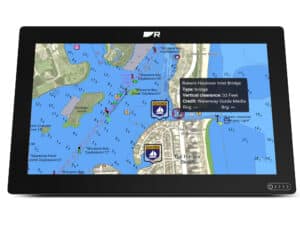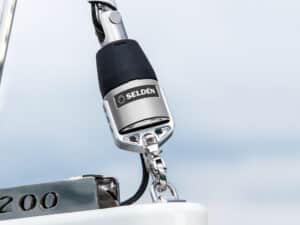A life jacket can save you-but only if you have it on. These PFDs have built-inharnesses and are comfortable enough to actually wear. A gear review from our November 2009 issue
You probably have a handful of those bulky orange life jackets in a locker that’ll satisfy U.S. Coast Guard safety requirements should you be boarded. But would you ever wear one unless it was absolutely-like the boat is sinking-necessary? And even if you’d wear it, it’s still not a harness that will help keep you attached to the boat. You don’t want to be left treading water while your boat sails away, do you? The solution is simple: Wear an inflatable PFD/harness and use a tether.
Most safety equipment is something you have to carry and hope to never use, but inflatable PFD/harnesses are different. They get used-as in worn-but not used-as in inflated-all the time. If you’re in the market for this piece of safety kit, there’s a couple of things to consider. First, do you want a manual inflator, in which you pull a rip cord to inflate the device, or would you like the security of having an automatic backup? (See “Inflation Mechanisms,” next page.) You should also figure out if a simple, easy-to-wear PFD will do the trick in lieu of one with an integrated harness. A harness model generally costs a bit more. If you’ll be doing any offshore cruising, a harness model will let you clip into jacklines and, in a worst-case scenario, be easily hauled aboard at the end of a halyard. On the other hand, if your plans include only daysailing and coastal cruising, a model without a harness will be better than not wearing any PFD at all.
After you’ve resolved these issues, it’s simply a matter of finding one that fits. Weight and fit will vary, so try on a bunch of different models until you find one that’s so comfortable that you’ll forget you’re wearing it-until you really need it. The following roundup of PFD/harnesses will help you get a feel for the choices.
Bill Springer is CW’s senior editor.
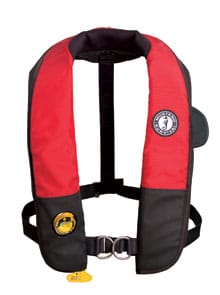
Courtesy of the Manufacturer| |Mustang Survival Inflatable PFD and Harness|
Mustang Survival Inflatable PFD and Harness
Mustang Survival’s sailing harness is equipped with the company’s exclusive Hydrostatic Inflator Technology. It automatically inflates only when submerged in 4 or more inches of water and not inadvertently due to rain, spray, or humidity. It also features the patented SecureZip closure system to ensure that the PFD stays closed during even the most rigorous activity and will still open efficiently when required. And it’s guaranteed to be maintenance-free for five years or until inflated.$310, (360) 676-1782, www.mustangsurvival.com
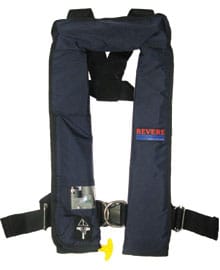
Courtesy of the Manufacturer| |Revere Comfort Max|
Revere Comfort Max
The Comfort Max is available with both manual and automatic inflators. When inflated, the bright-yellow bladder has additional reflective tape around the collar to aid visibility. The harness is built of sturdy webbing and has two steel rings to clip onto a tether. The bladder cover is available in red or navy blue. $200, (877) 738-3738, www.reveresupply.com
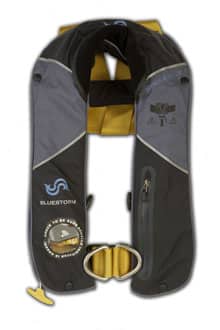
Courtesy of the Manufacturer| |X-treme Sail 33 DX from Blue STorm|
X-Treme Sail 33 DX from Blue Storm
This harness and PFD is equipped with an automatic inflator, and it can also be manually inflated by pulling a rip cord. The inflatable bladder is contained in a durable Cordura shell that has a small plastic window so you can easily see the status of the inflator (auto or manual) and reflective areas to make the vest more visible at night. The harness is made of sturdy, 2-inch wide webbing and has two beefy rings in the front for the tether. $210, (781) 831-6011, www.bluestorm.us
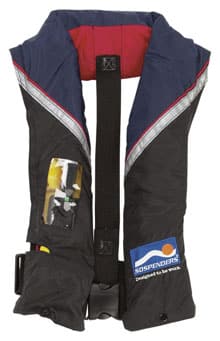
Courtesy of the Manufacturer| |Sospenders PFD with Harness|
Sospenders PFD with Harness
This unit’s cover and bladder are sewn together to form a one-piece unit that’s easy to wear, rearm, and repack. The bladder is brightly colored and has reflective tape for visibility. The PFD is available with manual and automatic inflators. The belt fastens using a 2-inch Fastex buckle that clicks when it’s locked.$170, (800) 835-3278, www.sospenders.com

Courtesy of the Manufacturer| |West Marine Ocean Series Hydrostatic Inflatable Life Vest|
West Marine Ocean Series Hydrostatic Inflatable Life Vest
This lightweight PFD/harness utilizes hydrostatic pressure that triggers inflation in 4 inches of water. It has a soft neoprene collar to help eliminate chafe around the neck, and the inflation cylinder is stowed inside the bladder to protect against corrosion. It’s also equipped with a small pocket, a strobe-light holder, a safety whistle, and reflective tape. The Ocean Series also has a manually inflated vest and harness.$300, (800) 262-8464, www.westmarine.com
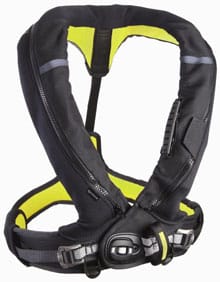
Courtesy of the Manufacturer| |Spinlock Deckvest|
Spinlock Deckvest
The Spinlock Deckvest’s unique design was initially developed for high-performance racers, and the result is a lightweight harness with an ergonomic 3D shape that puts a premium on comfort. It has a soft neoprene neck collar, cushioned fabric cover, and a unique neoprene belt that should help distribute the weight of the vest off the neck. It also has a lightweight, easy-to-use belt fastener, and comes with an integrated strobe. The Deckvest comes in three different sizes to ensure a perfect fit.$340, (877) 465-6251, www.spinlockusa.com
**
**
**
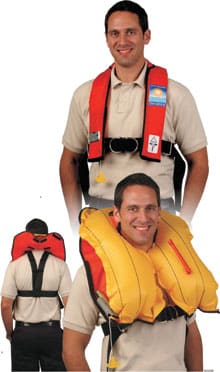
Courtesy of the Manufacturer| |Triumph II Sailing Harness|
Triumph II Sailing Harness
********The Triumph II Sailing Harness, from Eastern Aero Marine, is equipped with an inflatable PFD that can be triggered either manually or automatically. The bladder is contained in a fabric covering that comes in a choice of colors and has a built-in pocket to store a spare CO2 canister. The webbing harness is secured with a plastic clasp and has integral tether-attachment rings in the front. $150, (305) 871-4050, www.theraft.com
Inflation Mechanisms
All inflatable PFDs use small CO2 cartridges for inflation. Some vests can be inflated automatically (a sensor activates the CO2 canister); all of them can be inflated manually (the wearer pulls a cord to start the air flow) or orally (with a tube into which you blow). But there’s a difference in how the automatic inflators work. Hydrostatic inflators are activated by a change in pressure; when the wearer is submerged in several inches of water, it triggers the mechanism. Other automatic inflators use a disc that dissolves when it gets sufficiently wet and activates inflation. Both work if the wearer is in the water and unconscious, but accidental inflation is possible (in, for instance, heavy rain or spray) with the dissolving-disc models. Hydrostatic inflators are often more expensive and reportedly require less maintenance than the dissolving-disc inflators.
Armed and on an Airplane?
Some inflatable PFDs are available with a choice of inflators that are automatic, manual, or a combination of both. Most inflators have indicators that clearly show if the inflator is armed or not. In many cases, the indicators are visible through clear windows on the front of each vest. And most automatic inflators are relatively easy to rearm with a fresh CO2 cartridge. But things can get a bit sticky when you take an inflatable PFD through airport security. The Transportation Security Administration reportedly allows PFDs with CO2 cylinders through security, but the airlines can raise a fuss. It’s best to confirm beforehand with your airline if it allows an inflatable PFD on board. If it doesn’t, you should be allowed to disarm the inflator and stow it in your checked luggage.



